LXR-02 is what the world needs now: a drum machine with its own personality and soul. It slaps harder, plays easier, and does grunge, glitch, grime, and digital mayhem unlike anything else.
Hard sounds, easy interface
You can buy deep, do-everything drum machines, and you can buy drum machines made to sold like old drum machines. But the LXR-02 – before anything else – is a performance drum synth. Everything here is about giving you lots of flexible synthesis for sound, then making it stupidly easy to access, with surprising and empowering depth for modulating and processing sound.
That accessibility matters, especially if the idea is to tweak, jam, and perform. On paper, there are machines that do more, but they tend to bury those abilities under a lot of hierarchy. Not so, the LXR. The LXR-02 not only sounds special and has a particularly versatile and direct architecture, but it has a completely flat UX that makes it fast to work with.
It’s also got all the I/O you’d want – MIDI in and out, four assignable outs (two stereo pairs), headphone out, USB connectivity (with onboard MIDI), analog clock in and out, and SD card (for project data – no sample support, sorry).
Take a listen – Erica are unique in balancing their musical tastes with their hardware tastes, so they’ve done some stunning demos. I’m still working on mine; it’s hard to top this:
I’ll say, though, even posting a few seconds of jams on Instagram I had people falling in love; it sounds good through an iPhone mic. It’s one of those devices whose character shines no matter what.
And my God. It’s full of transients.
LXR: Origins
The LXR-02 is really a new, ground-up instrument created by Sonic Potions in collaboration with Erica Synths. But it is inspired by the earlier LXR from Sonic Potions, the project of independent researcher/developer Julian Schmidt, now in Schwärzelbach, Germany. (He’s been at this for a long time, including on the John Bowen Solaris and Scope DSP.)
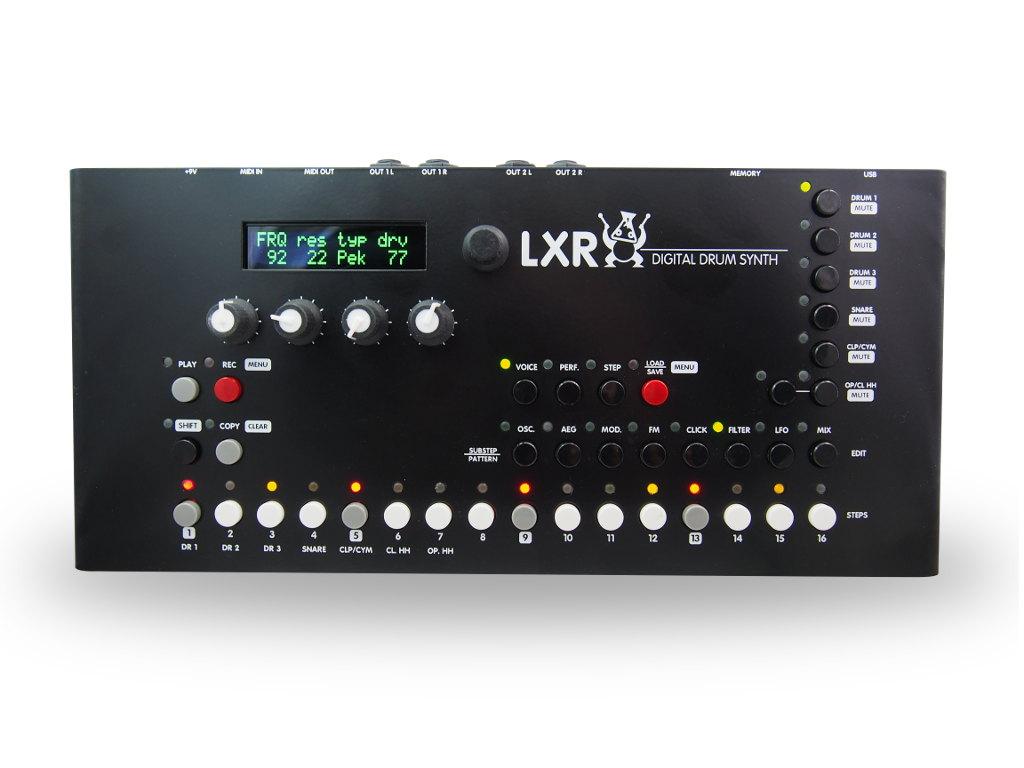
The earlier LXR’s basic architecture, layout, and concept are all on the LXR-02, but have been fleshed out. And to be fair, while the LXR was a darling of DIYers, it was only available as a kit and had some limitations and rough edges here and there. So it wasn’t really ready for a primetime audience. The LXR-02 has the significantly beefier horsepower, thanks to evolving ARM platforms, and realizes a lot more of the potential of the original. (Original LXR owners, being a DIY sort, you may see some improvements ported there, too – to the extent the hardware can take it.)
The reason people are excited about the LXR-02 is that it takes the best ideas of the LXR – six dedicated voices with loads of parameters to tweak, a ton of modulation, and copious sequencing flexibility – and rounds out the package with faders and extra finish.
And that means when you use the LXR-02, even without knowing its predecessor, it has a wonderfully eerie sense of familiarity and inevitability.
Of course, this also reminds me of that crazy labor-of-love controller, the 60KNOBS Bastl Instruments made for the original LXR. But let’s get back to the LXR-02, because while a unique controller could still be fun, the Erica-Sonic Potions creation is usable straight out of the box.
Physical controls, rapid workflows
The LXR-02 is remarkably compact – only barely larger than a KORG volca, smaller even than a Roland MC-101 or Boutique – but comes in a sturdy metal case with solid, stable controls.
You get arrays of dedicated buttons, four encoders paired with the display, a big vintage-style signature Erica DATA knob, and dedicated per-voice faders plus a master volume fader. Of course, the buttons at the bottom are a standard x0x-style (Roland) step sequence layout.
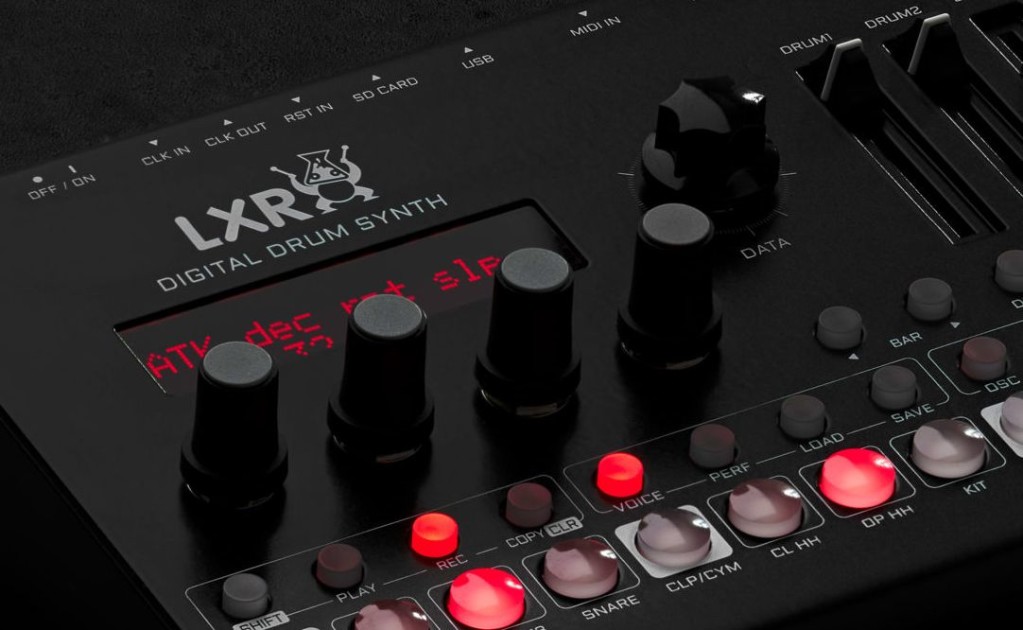
But wow, can you do a lot with one-button (or SHIFT+press two-button) access. A brief list:
- Play and record
- Copy (shift+copy to clear)
- Mute (directly toggled in Performance mode, or shift+the voice you want to toggle in Voice mode)
- Nativate bars (4 bars of 16 subdivisions each)
- All sound pages – oscillator, envelopes, modulation, FM, click, filter, LFO, and mix pages all have their own dedicated buttons
And then with the SHIFT key, you can access each of the sound engines, morph, song, project, configuration, reload, last step, effects, and pattern pages.
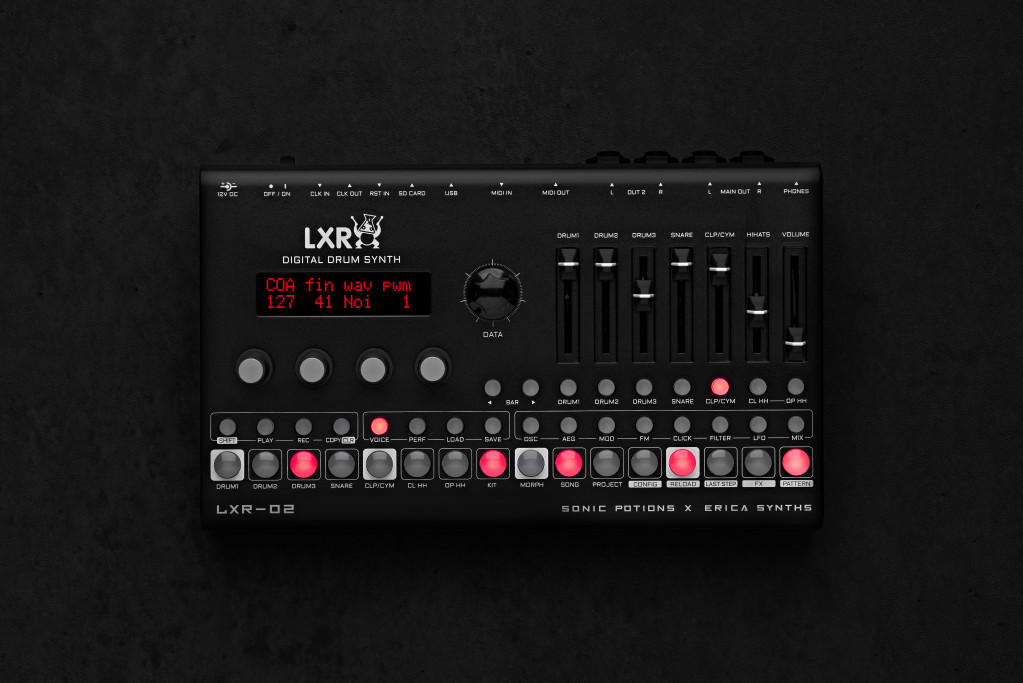
You always have direct access to up to four parameters via the encoders and volume via the faders. Dialing that clicky DATA knob lets you breeze through different parameters, push-to-select, and get precise control over digital settings.
It’s simple but effective – the display – plus – four encoder setup is familiar from other DIY favorites like the Mutable Shruthi and PreenFM and their relations.
But even without lots of hierarchy, you still have tons of control over sound. And it’s so fast, that you don’t have to stop, navigate, think, and then shape sounds – you just get at everything right away and mess around, which for many of us is the reason we use hardware in the first place.
Plug it in. Sync it up with other gear (maybe your computer, maybe hardware). Dial in a sequence. Shape each voice. Add modulation. Add effects. Mix, morph, play.
Architecture and sound shaping
The core of the LXR is its six voices – three Drum voices, Snare voice, Cymbal/Clap voice, and Hihat voice. (The last of those has separate pages for closed and open hats and dedicated triggers.) Each is a sound engine of its own, with its own architecture. As the names imply, they have particular applications in a drum kit in mind, but there’s nothing stopping you from warping them into something else – or even thinking of the LXR as another synthesizer and not only a drum machine.

The Drum voices are most like a conventional analog emulation, covering the kicks, toms, cowbells, and whatnot – so sounding like a Roland TR or other classic machine if you want, but also morphing into other sounds, too.
There’s also an FM mode and corresponding page for all three Drum voices.
The Snare voice is a noise source with a pitched oscillator.
Cymbal/Clap is a 3-operator FM engine, covering all the metallic business.
The Hihat voice is similar, but with two different decay times – so you can think of it as a longer-envelope variant of Cymbal/Clap.
That’s a lot already – notice all the FM (in each Drum voice plus the Cymbal/Clap engine) – but it’s the extra toppings that make the LXR an LXR:
Every single voice has its own Transient Generator. That lets you layer – and pitch – any one of several transient wave shapes on top of every single voice, for clicks and thumps and whacks to mix with the sound. That’s a whole lot of added slap on everything, and since each transient has its own volume control, you can dial in as little or as much as you want.
Every single voice is also routed through Distortion and Samplerate Reducer sections, too.
So let’s say that again – you can dial in as much transient slap on each voice as you want, and distortion (analog or digital), and sample rate reduction (for digital degradation). There’s even added access on the Performance page to sample rate reduction for even more bit-crunchy goodness.
You can quickly shape the sound with one-press access to pages for oscillator, amplitude envelope, modulation, FM (where available), click (Transient Generator), filter, LFO, and mixer. You can sculpt oscillator waveshapes, coarse and fine-tune everything (even coarse-tune the noise source). Drums 1-3 have custom amplitude slopes. Snare/cymbal has variable amplitude slopes and a variable number of retriggers. There are fine-grained controls for FM (on a dedicated page, even).
It’s not only lo-fi digital sound – you can get rich analog-style timbres and plenty of sonic precision, too, especially with the excellent (modeled) filter section. For a box with a range this broad, it’s also remarkably easy to get satisfying sounds across that range.
You also have extensive modulation options – that’s also good for playing from an external controller, since you can route note velocity to any parameter.
Everything is also MIDI-assignable – and I do mean basically everything; check the manual’s MIDI implementation guide. The manual even includes a helpful narration of drum synthesis basics which you can apply to your experiments inside the LXR. Everything feels intuitive and tweakable – enough so that, confession time, yes I did start tweaking some things to my satisfaction even before I worked out what every abbreviation on the screen meant. It doesn’t matter.
This machine just endlessly rewards tweaking, mindful tweaking or not.
Effects and Mixer Page
The Mixer Page you’ll use a lot, too. It has volume and panning, plus some handy access to options to make the LXR even more dirty and glitchy. Sample rate decimation and a soft clipping Drive are both here, too, and they can make your kits even grimier, sort of cheap digital stompbox-style.
You’ll also find Track length (len) and routing options necessary to set up not only output but also effects, plus some MIDI options, all added to the Mixer page as a kind of catch-all.
Track length itself is basically redundant since you can simply use the LAST STEP option (see below). Routing is essential to setting up effects, though.
The Mixer page lets you set the output of each part to the main outs or outs one two – which means if you don’t need stereo, you have up to four dedicated hardware outs even if you see only two stereo pairs.
From there, you can also set the FX routing.
Effects are limited to just one effect at a time, as an insert (not a send). That said, keep in mind that’s in addition to FM, modulation, transient adjustment, a dedicated Drive per part, and a dedicated sample decimation per part, so these fairly gnarly digital effects might best be used one at a time anyway.
To route each voice to effects, you set its mixer page output to FX, and then route the FX to the audio output of your choice. That’s a little confusing, as you’ll set OUT to FX and initially not hear anything, especially given the default parameters, but then –
SHIFT + FX opens the effects page.
Set TYP to choose which effect you want.
Set the parameters.
The effects and mixer pages are the only pages that are a little confusing to follow – not least because the parameters are set to zero, including RNG – so there are several zeroed-out parameters that defeat the use of the effects. I wish that Erica and Sonic Portions had voiced this a bit differently so that you have usable defaults when you first instantiate one of the effects; it seems like some support confusion waiting to happen.
Once you get over that hurdle, though, these effects are deceptive – there are some powerful options here. The Delay has a range control because the delay time can range from 1-20ms all the way to 20ms – 0.7 seconds and various options in between.
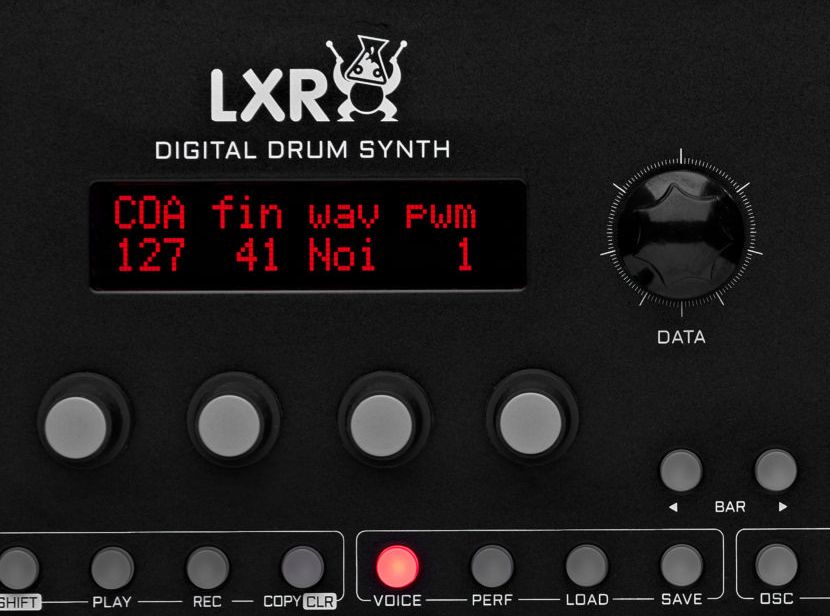
And everything is, again, dirty, gnarly, digital, lo-fi – all in a nice way, with the kind of weird quirks and clipping other digital gear has ironed out so much as to sometimes be, well, boring.
Really the main disadvantage is this clunky routing. You can choose all-or-nothing to route a voice to the effects, but you don’t get a send control for doing so. I wouldn’t mind seeing that addressed, but meanwhile, you can embrace the lo-fi sense here.
And each effect is compelling, once you understand and tame it:
Drive has a choice of algorithms for tube saturation, wavefolder distortion, and pedal-style hard clipping (yes, like the RAT)
Ringmodulator multiplies the input by a second oscillator signal (internal here), with a choice of waveforms – this is really a favorite of mine
Compressor is a perfectly usable basic dynamic processor configurable from 1:1 to *;1 with attack, decay, threshold, and makeup gain
Delay is currently just a single digital delay, but it lets you toggle between low and high time ranges, from 1-20ms and 20ms – 0.7s, respectively. That makes it eminently usable for everything from dubby delays to tight flanging sounds.
The Drive is pretty digital and gnarly, but do spend some time with Delay and Ringmodulator, as they take this already versatile unit and open up a lot more.
It could make some sense to pair the LXR-02 with another effect unit if you want a little more nuance or reverb, and the extra assignable outs will clearly come in handy in that scenario.
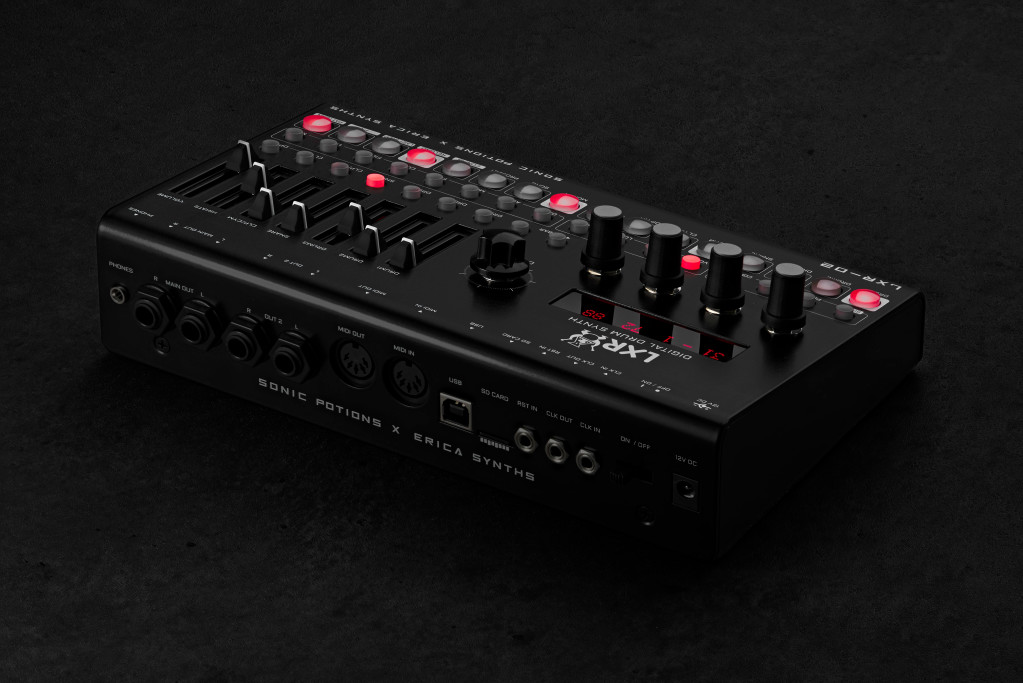
Programming and performing patterns
At its most basic, the sequencer on the LXR will be familiar – select a part, push steps on and off, with dedicated buttons 1-16. Each track contains up to 64 steps – 4 bars x 16 steps, easily navigated using dedicated buttons.
Those steps do remain the same length – determined by the master tempo.
There’s parameter automation, too – including parameter locks (p-locks). You have three ways at getting at that:
- Live: Hit REC and automation is recorded in real-time
- P-lock: Hold one of the step sequence buttons (in VOICE mode) and twist one of the four encoders to lock a parameter.
- Step edit: For a little more precision, choose step edit mode and set parameters directly.
Each step has a probability control, as well.
With LAST STEP, it’s possible change track length, including creating polyrhythms or polymeters (since it’s set per track). You set it with SHIFT + LAST STEP and then press the step you want or dial it in. (You can also change length by full bar at once.)
I do miss having the ability to directly edit sub-steps – that’s available even on my Roland TR-8S. (I’m going to assume that changing per-step length is way beyond the league and brief of this device.) But you do get something like sub-steps using rolls, which can be recorded – see the next section.
There is also a Song Mode for stringing together patterns with either END or LOOP markers.
Shuffle is available, globally only.
The sequencer itself is one of the more basic areas of the LXR; it covers all the basics and p-locks are great, but this does feel more like a synth than anything else. There’s no external sequencing capability, either. I think if it’s really a sequencer you’re looking for, you may want to sketch on the LXR but use an outboard sequencer for additional control (and for sequencing other gear that doesn’t have the capability onboard).
That said, I’m okay with the LXR keeping it simple here, especially because there are some surprise twists – and pattern tools – in the performance mode.

Morphing and live performance
Morph kits!
This is just stupidly well-implemented on the LXR – exactly the kind of dead-simple genius that exemplifies this box.
It works like this. Pick two kits – any two kits, perhaps one you made and saved yourself. Load the first kit. Now press LOAD + MORPH and select the second kit you want, then push the encoder.
From the PERFORMANCE page, you can now adjust morph (well, “mrp”) and smoothly morph from any kit to any other kit across all those juicy wonderful LXR parameters. It works across the LXR’s sound engines brilliantly.
There are some other little tricks for live performance on the PERFORMANCE page. (Truth be told, you’ll likely jam on all the other pages, too, but it still fits.)
With PERF page selected, holding down the first buttons of the sequencer trigger a cute little repeat mode Erica/Sonic Potions call MANUAL ROLL – buttons 1-7 for voices 1 – 6 (6-7 control closed and open hi-hats, respectively).
Those rolls are recorded, too, if you toggle REC, so this is an especially easy way of recording hi-hat patterns and the like quickly.
The roll feature though is the one that seems like it’s due for a firmware update. For one, while you can change the roll speed, you can only do so by turning the “rol” encoder, and only in basic duple divisions – whole note/bar, ½, ¼, 1/8, and 1/16, plus an inexplicable “ONE” that … means it doesn’t repeat at all. Triplets, at least? You also can’t access rolls from a part, and as I noted earlier, there’s no sub-step editing.
And then there are those extra buttons that don’t do anything on the PERF page… and room for more parameters…
Anyway, while hopefully that shows up in a future firmware update, that let me sing the praises instead of the Pattern Generator Mode.
SHIFT + PERF and you enter a completely different screen where you can generate and modify patterns. Set length per track, number of active steps, rotation (shifting by step to the left or right), and morph.
Choose a target track with one of the seven voice buttons, and it will spawn a new pattern the moment you change the length or number of steps.
It’s great both for quick inspiration or immediate variations in live performance mode. It’s actually so great that I could imagine this mode, like MANUAL ROLL, getting expanded in a firmware update.

In use with HRTL
I spoke a bit to artist HRTL (aka Czechia’s own Leoš Hort) about this creation. He’s someone who worked on preset content for the LXR-02, and was an owner and “long-time fan” of the original LXR, as well as being the one behind that 60KNOBS madness.
“What I expected was pretty much my good old LXR in new clothes, but the experience is really different,” HRTL says. That’s thanks to the faders, new encoders, swift editing and workflow – enough that you don’t need an external controller anymore. That’s saying a lot I think, as some of the big brands (cough, Elektron) do often wind up demanding plugging in an extra controller.
And then being able to modulate anything using dynamics “brings it alive and makes it oh so responsive.” So instead of plugging in a fader box, you can plug in a keyboard and really play.
The new effects section means entirely new colors and raw sounds and dubby delays and more. And HRTL says he was happy integrating with a modular using just the clock I/O.
And make use of the LFOs. The LFOs are triggerable, so you can use them as an envelope. You have up to six LFO sources, so that frees up extra sources to add some subtle randomness or modulation in the stereo image, he says.
I love HRTL’s live sets so let’s all bug him to do one for CDM using this box. Or hope the two of us can even jam together soon.
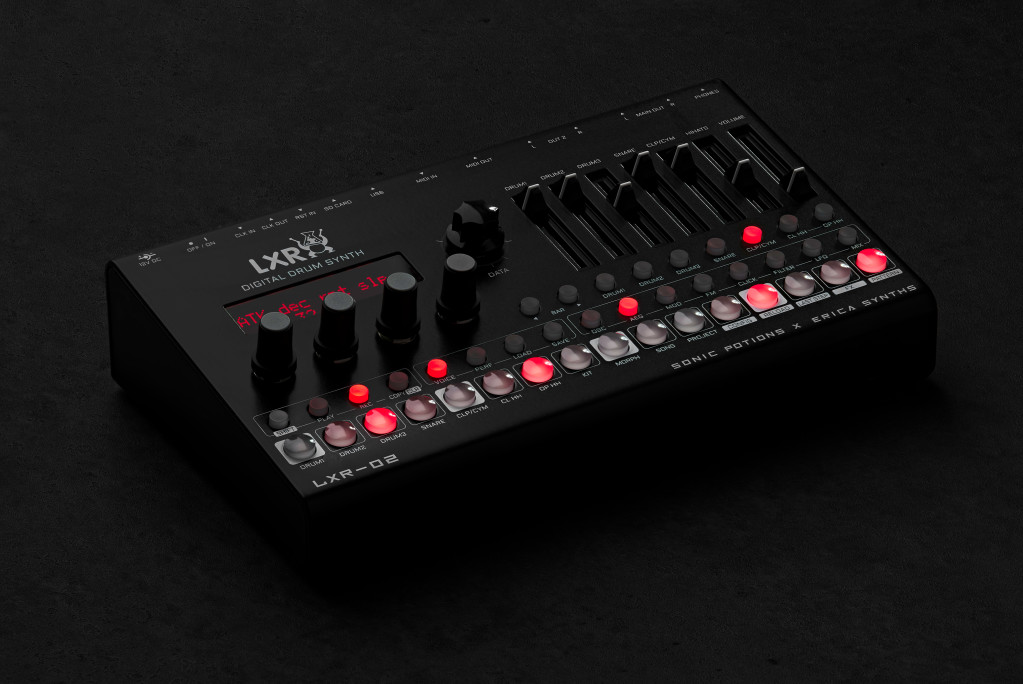
Conclusions
The reason for this deep dive is simple – finally, there’s a breakthrough drum synth for synthesis lovers, built like a tank but ultra-compact and accessible both in price range and usability.
And wow, is it deep. The rich modulation options and the possibilities of effects – even with just one insert slot – are just exceptional. It feels like someone hid a little modular rig in there, but it’s as quick to program as a drum machine can be. The effect instantiation is a bit weird, but that’s just a matter of working through building some presets.
Without overcomplicating the sequencer, I would still like to see some refinement added to rolls. And some of those empty pages here and there seem tantalizing, if they haven’t totally run out of horsepower.
But the LXR-02 is just special. It really stands alongside a history of new-century boutique boxes, along with the greats from MFB and JoMoX. It’s another reminder that there are still new ideas out there from independent underground designers. And it’s an instrument you’ll want to use to create some new and underground ideas of your own.
https://www.ericasynths.lv/shop/standalone-instruments-1/drum-synthesizer-lxr-02/
Erica Synths LXR-02 is € 490.00 (before 21% VAT for European customers). Availability currently from late August.